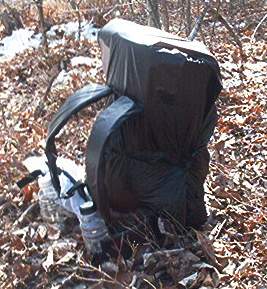My 8 Ounce Silnylon Pack

This pack measures 22 x 8 x 13 inches, and has a capacity of 2,288 cubic inches. In addition, there are 5 pockets: one on the top cover flap, and 4 external that are 9 x 10 inches each. Overlapping flaps and Velcro closures insure safety of gear. There is a draw cord closure. A closed cell pad rolled up lengthwise and placed inside like a cylinder (and then allowed to expand) gives the pack its shape. As you can see, it will stand unaided if packed in this manner.
I sewed two mesh pockets on the outside, which turned out to be very useful, bringing the pack's weight up to 9 ounces.
A hip belt is sewn in with webbing reinforcement. This belt measures 3 inches wide, and ½ inch thick. Even with ultralighting, hip belts have been proven both useful and necessary during long sections between resupply. One good friend, who was able to do 38-mile days, still carried out nearly 20 pounds of food, in addition to his 9 pounds of gear. Water adds additional weight, bringing an ultralight pack to a total weight of over 32 pounds in real life situations.
In Waynesburro, I formed pockets in the hip belt fabric by cutting and hemming the top of the fabric which surrounds the inside foam. This allowed me to carry my chlorine on my hip belt, making it very easy to treat water without removing my pack. I carry my day-use chlorine in a small breath drops bottle.
Shoulder straps were made also from silnylon, and closed cell padding inserted. They may appear to be overkill in this photo, measuring 3 inches wide, and ½ inch thick.
The shoulder straps had a tendency to slide off (being made of silnylon), so I snugged them closer together, and stitched them again. The wide padding distributed the load nicely. It was a good width for me.
20 ounce capacity water bottles will be carried on the front straps utilizing a shock cord band, a trick I learned from a dear friend on the PCT. This provides for easy access and supposedly a counterbalance for pack weight. I changed to two 24 ounce bottles, which became my total capacity in areas of abundant water. For a while I carried a Platypus water bag to collect an additional 2 quarts of water for camping use at night. I made some silnylon water bottle bags and threaded them onto the shoulder straps because the full bottles seemed to slip down as I hiked. I felt they might eventually get lost, and the bags totally eliminated that problem. They did indeed work as a counter balance, and having two allowed me to give my water treatment time to work as I alternated between bottles. Unlike a Camelback water system, I always knew how much water I was carrying, and could easily pick up more without removing my pack. Some of the technical aspects of the pack's construction follows: It was made totally out of silnylon and my design is based on the principle of one bag set within another, and the bottoms of said bags sewn together (at the bottom of the pack) and the pockets formed by stitching the sides. The result of this type construction is that the pack has a double thickness of fabric at the bottom. A cover flap for each pocket was incorporated by using length of the inner bag. Like most fabrics, the least cutting possible (with reinforced stitching) using triangular patterns serves to maintain the strength of the item.
Loops were sewn into the bottom seam, in case I need to attach a stuff sack underneath. At this point, all my AT gear (even for cold weather) fits inside, and in the pockets. The extension collar / cover flap will allow my food bag to be placed on top.
I believe this pack is durable enough to make my entire AT thru hike in 2002. Weighing only 8 ounces, I will certainly give it a try. Silnylon is remarkably strong and easily repaired trailside. When my hike has been completed, I'll update this page.
I never did need to cinch anything on the bottom, nor add an extra bag for food to the top. Some mesh pockets were added to the outside, which became my main access pockets. I really loved the top flap pocket. The pack made the entire trip, although suffering one three-inch tear when it snagged a sharp broken pine branch on a steep descent over rock slides. This was repaired trail side with black electrical tape and super glue. It dried within minutes and remains fully intact.
I plan to make another pack, having retired the one you see here to an honored place on my wall. It received a lot of attention and marvel on the trail. When it was empty and hanging on the shelter wall, it resembled a glorified stuff sack, complete with my PCT 2600 miler patch.
There will be a few changes in the design, incorporating all the things I learned about this one, including just a few extra inches of length. The width was great. When the new one is ready, I hope to show you that one as well.
Page updated August 21,2002 after the completion of my Appalachian Trail Thru hike on August 14, 2002. The updated text appears in italics.
